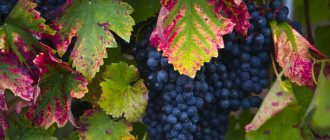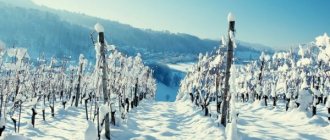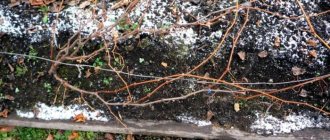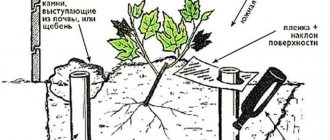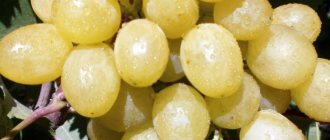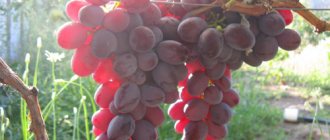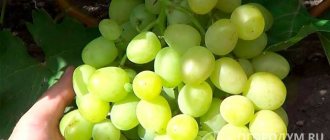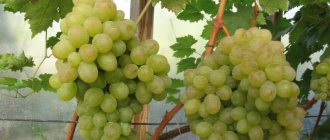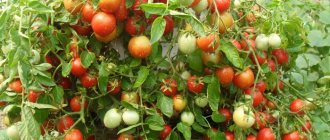Characteristics
| Characteristics of the Bianca family | |
| Parent couple Bianca | Chasselas Bouvier and Villars Blanc |
| Homeland of the species: | Hungary |
| Main characteristics of Bianca | |
| Purpose: | technical |
| Ripening time: | early |
| Productivity: | high |
| Taste: | harmonious, sometimes with honey and floral shades |
| Color: | yellow-green |
| Frost resistance: | up to — 27°C |
| Description of the bunch | |
| Bunch weight: | 150-200 gr. |
| Bunch density: | dense |
| Description of grapes | |
| Berry shape: | rounded |
| Berry weight | 1-3 gr. |
| Diseases | |
| Disease resistance: | Resistant to mildew, oidium, gray rot, phylloxera. |
By August, small, conical-looking clusters form on the bushes.
With proper care they grow to 170-200 grams. The grapes are round, weighing 2-2.5 grams. The color is greenish; as it ripens, the skin acquires warm amber shades. The pulp contains a large amount of water, the sugar level is 28%. There are usually 2-3 seeds inside. The skin is thin but durable.
Acidity levels are above average - 7%, so experienced winegrowers prefer to keep the berries on the vine. Two to three weeks are enough for the fruits to gain sweetness and acidity to decrease. Alcohol content – 14% (high).
On a note!
Due to high sugar levels, grapes are susceptible to attack by birds and wasps when ripening. In order not to be left without a harvest, protective measures (nets, ratchets, fabrics) are thought out in advance.
Productivity – 180-200 kg per hectare. Fruiting of the vine is 80-85%.
Bianca has not only unsurpassed taste, but also a large amount of vitamins, as well as other substances necessary for the normal functioning of the body.
- The variety helps to increase the body's resistance to various pathogenic bacteria.
- It has a healing effect on all organs important to human life.
- The plant removes harmful cholesterol.
- Bianca has a strengthening effect on the circulatory system.
- Effectively fights sleep disorders.
- Activates the work of the gastrointestinal tract, liver, kidneys and pancreas.
- Bianca has a positive effect on vision.
- Improves mood.
Regular use of Bianka contributes to the overall strengthening and rejuvenation of the human body. There is a positive effect on the condition of hair, nails and skin.
But abuse of this berry is also not recommended. The fact is that grapes can cause an allergic reaction, which can, in an aggravated form, lead to anaphylactic shock.
Externally, the plant is a low-growing bush with dark green leaves, medium in size, the bush is strewn with crowns of spherical grapes of yellow-green color with an amber tint.
The weight of the fruit is 2-3 grams, they have a very sweet taste, the weight of the clusters does not exceed 250 grams, and the size ranges from 22-25 centimeters. Bianca is characterized by small cylindrical clusters. The pulp pleases winegrowers with a pleasant taste and high juice content. The grapes are covered with almost imperceptible skin, and the content of seeds does not exceed 2-3 pieces. The sugar and alcohol content reaches impressive values.
Due to its attractive appearance, the variety has found its use not only in the production of alcoholic beverages, but also as an excellent way to green an area.
By August, small, conical-looking clusters form on the bushes. With proper care they grow to 170-200 grams. The grapes are round, weighing 2-2.5 grams. The color is greenish; as it ripens, the skin acquires warm amber shades.
The pulp contains a large amount of water, the sugar level is 28%. There are usually 2-3 seeds inside. The skin is thin but durable.
Productivity – 180-200 kg per hectare. Fruiting of the vine is 80-85%.
I have been cultivating Bianca grapes for ten years now. The variety is frost-resistant (I never cover it for the winter), productive and immune to most diseases. Every year I make several dozen liters of wine - excellent sweet taste with a floral aroma. Every season I treat the bushes several times with insecticides and acaricides, maybe that’s why there are no diseases.
We have been growing the Bianca fruit grape for seven years. With rather low-growing bushes, the variety is characterized by high productivity and unpretentiousness, and is resistant to diseases, although it must be treated several times for preventive purposes. It was never covered for the winter; only one bush froze, but then recovered.
Advantages: high frost resistance, immune to diseases, excellent yield;
Disadvantages: suffers from bird and wasp infestations.
Recently, winegrowers have increasingly begun to pay great attention to wine grape varieties. This fact is due to the unpretentiousness of many varieties and the minimum costs used in growing crops. One of these plants is the Bianca variety.
Externally, Bianca is a low-growing vine with dark, slightly dissected, medium-sized leaves, with abundant clusters of small white berries with a greenish tint.
The berries have dense thin skin, juicy pulp with a high content of sweet juice. The sugar content of the berries is about 20-28% and exceeds the acidity. Angelica, Krasa Nikopolya and Lydia also demonstrate high sugar content.
The vine is characterized by good ripening of shoots and rooting of cuttings. Fruit buds are laid every year.
Externally, Bianca is a low-growing vine with dark, slightly dissected, medium-sized leaves, with abundant clusters of small white berries with a greenish tint.
The berries have dense thin skin, juicy pulp with a high content of sweet juice. The sugar content of the berries is about 20-28% and exceeds the acidity. Angelica, Krasa Nikopolya and Lydia also demonstrate high sugar content.
The vine is characterized by good ripening of shoots and rooting of cuttings. Fruit buds are laid every year.
The variety is characterized by good fruitfulness of shoots (up to 100%) and yield, early ripening (in some regions of Russia the harvest can be harvested in August).
Bianca is a very frost-resistant variety, can withstand temperatures down to -27 degrees, making it easier to care for grapes in the autumn-winter season.
It does not need shelter in winter and recovers well after frost. Ruta, Zarya Nesvetaya and Denisovsky show the same signs.
It is characterized by transportability and can remain on the bushes for a long time, accumulating sugar and reducing acid.
For reference, Russian technologists, as a result of research in the Don and Kuban, revealed that it is possible to obtain a high level of coincidence between crop quality and high productivity by intensively cultivating the variety.
In this case, the bushes (small cup-shaped) are planted according to the scheme 3-3.5 x 0.5-0.7 m, without the use of trellises, or using a simplified trellis.
During cultivation, the vine is pruned into 2-3 buds, the load per hectare is imposed from 90 to 140 thousand shoots.
Appearance of grapes
Externally, Bianca is a low-growing vine with dark, slightly dissected, medium-sized leaves, with abundant clusters of small white berries with a greenish tint.
The berries have dense thin skin, juicy pulp with a high content of sweet juice. The sugar content of the berries is about 20-28% and exceeds the acidity. Angelica, Krasa Nikopolya and Lydia also demonstrate high sugar content.
The vine is characterized by good ripening of shoots and rooting of cuttings. Fruit buds are laid every year.
Description of the variety
Externally, the Bianca grape appears as a low-growing vine with small, dark foliage with abundant clusters. The berries are covered with dense thin skin. The grapes are juicy and contain a large amount of juice. In this plant, fruit buds are laid every year, and the ripening of the fruits occurs very quickly.
The description of the plant indicates that the domestic grape variety Bianca is a hybrid. This variety was developed by Hungarian winegrowers back in 1963. During the formation of the species, they crossed two grape groves - Villars Blanc and Chasselas Bouvier.
Viticulture is gaining momentum every year. Amateur gardeners are interested in the question of what care should be like in the middle zone and the Moscow region. How to plant a vineyard correctly? This variety is credited with good fruiting. In some zones of the Russian Federation, the harvest is already in August. In this case, small cup-shaped bushes are planted according to the scheme 3-3.5x0.5-0.7 m.
Bianka grapes
The grapes were obtained by Hungarian breeders, the parent pair is Chasselas Bouvier and the famous sweet Villars Blanc. Bushes of medium vigor, with dense shoots. Maturation – 90-100%.
It is distinguished by the rapid rooting of cuttings and the active growth of young vines. Leaves with five distinct lobes, dark green in color. The appearance of the bushes is very decorative, so Bianka is used to decorate areas.
The harvest is ready for harvest in 120 days (early type of crop). In the southern regions, berries are harvested in early August. After planting, the first clusters appear in the third year. There are 2-3 inflorescences on the shoot.
The variety is frost-resistant, can withstand temperatures down to -27ºC. This allows Bianca to be grown in regions with short summers and harsh climatic conditions. But mainly technical species are cultivated in the south. Thanks to good growth, the vine quickly recovers after freezing.
Usage:
- preparation of table and dessert wines;
- production of vodka;
- production of cognacs of various ages and strengths.
Wine experts note the pleasant taste of wine drinks made from Bianchi berries.
Grapes of this type are resistant to pests; a resistance gene is embedded at the genetic level. This makes it possible to treat the vineyards with chemicals to a minimum and obtain an environmentally friendly product.
Bianca traditionally belongs to the technical (wine) varieties used for the production of white table and fortified wines. The varieties Levokumsky, Augusta and Crystal also belong to the same type.
However, due to its properties it can serve as a raw material base for cognac production.
It is important to note that this use of the Bianca variety is even preferable, thanks to its alcohol, which is distinguished by its bright organoleptic properties, mild pleasant taste and vanilla-almond tones in the aroma.
The pomace produces wonderful grape vodka (grappa) with a subtle, spicy aroma.
Advantages and disadvantages of the variety
Bianca is included in the list of the best wine varieties and is recommended for cultivation in industrial quantities.
Advantages:
- early harvest dates;
- disease resistance;
- stable harvests in regions with different climatic conditions;
- high content of sugars, alcohols, moderate acidity;
- successful survival on the rootstock;
- stays on the bushes for a long time, does not fall off;
- responds well to molding.
Flaws:
- protection from wasps and birds is required;
- due to the small size of the bunches, manual harvesting is difficult;
- bushes need to normalize the load.
The shortcomings are compensated by the excellent taste of the berries and the ease of caring for the vineyard.
Bianca is included in the list of the best wine varieties and is recommended for cultivation in industrial quantities.
The use of berries is universal, although they are more often used as raw materials in winemaking.
The shortcomings are compensated by the excellent taste of the berries and the ease of caring for the vineyard.
Harvest safety
The berries do not lose their value, coloring the autumn garden with full clusters for a long time. Small brushes of this variety (a little over 100 grams) are not very convenient to collect. The labor-intensive process of harvesting is more than compensated by its quantity and quality.
Bianca is a variety that:
- remains on the bushes for a long time;
- accumulates sugar, loses a little acidity, remaining hanging on the vines; does not waste its advantages when it stays on the branch for a long time after ripening.
Manual assembly has advantages. During harvesting, the berries are not subject to technical damage, are not crushed, and come into less contact with hard parts of the plant. They are more suitable for further processing.
The high sugar content of the variety attracts wasps and birds
To protect against the former, containers with poison dissolved in sweet water are placed next to the bushes. Wasps flock well to the mixture. You can burn wasp nests, but it is unlikely that you will be able to find them all.
For birds, use a mosquito net or something similar.
Wasps love to feast on Bianca
History of selection
Bianca is a hybrid grape variety that was bred in 1963 by Hungarian breeders by crossing two varieties - Villars Blanc and Chasselas Bouvier. Among the hybrids, Delight Black, Monarch and Vanyusha are also known.
Distributed in many wine-growing regions, including the south of Russia (Rostov region, Krasnodar region), Ukraine, Belarus and other countries (Poland, Germany, etc.).
The Bianca variety is a wine variety. It is used to make white wine. But given the characteristics of Bianca, this variety has proven itself in the production of cognacs. You could even say that it is used primarily to make this strong drink. The alcohol included in its composition has excellent taste.
Bianca is a hybrid grape variety that was bred in 1963 by Hungarian breeders by crossing two varieties - Villars Blanc and Chasselas Bouvier. Among the hybrids, Delight Black, Monarch and Vanyusha are also known.
Distributed in many wine-growing regions, including the south of Russia (Rostov region, Krasnodar region), Ukraine, Belarus and other countries (Poland, Germany, etc.).
Features of agricultural technology
The variety requires standard care. It is enough to follow basic agricultural techniques, treat plantings from pests in a timely manner, and form bushes.
Watering
Bianca is a moisture-loving grape, so the soil should not be allowed to dry out. Water into holes or specially dug grooves. In large areas, it is recommended to install drip irrigation systems. The norm for an adult bush is 6-7 liters (the weather and the condition of the plants are taken into account). On hot days, water more often, every other day.
When mulch is used, the soil dries out slowly and weeds do not grow.
On a note!
During flowering, Bianca is not watered; watering is also stopped 18-20 days before the grapes are fully ripened.
In autumn, when there is little rain, water-recharging irrigation is performed. It will provide the roots with moisture and increase the resistance of the shoots to frost.
Feeding
The main fertilizer is added to the holes when planting seedlings. Over the next three years, the plantings are not fed.
Adult bushes need regular feeding:
- organics (every two years, 4-5 kg per square meter);
- mineral fertilizers (3-4 times per season).
In the spring, before flowers appear on the bushes, water Bianka with solutions of urea and potassium salt. They feed the second time when the grapes have become the size of peas. Reduce the dose of nitrogen additives, increase the rate of phosphorus and potassium fertilizers.
During the period when the berries are filling with juice and ripening, it is recommended to feed the vineyard with potassium salt, superphosphate, and ash infusion.
After harvesting the fruits, treatment of the bushes with special compounds with microelements is indicated: Polydon Iodine, MicroMix and others.
In cloudy weather, spraying grapes on the leaves with solutions of Master, Novofert, Kemira gives a good effect.
Bianka gives a high yield when bushes are planted densely and pruned using cup-shaped technology. The method is suitable for the southern regions; pruning is done from the second year to 2-3 eyes.
Formation is carried out over 4-5 years. It is advisable to form compact bowls to reduce the load on the shoots. The height of the trunk is 80-100 cm (if cultivated without trellises). They also practice growing on a simplified trellis with one wire.
Autumn pruning is carried out along mature shoots, before covering the vine in a trench for wintering. The main work is postponed until spring, pruning the bushes before the buds begin to open.
In addition to removing weak, fattening vines, old sleeves are removed and the necessary load on the bushes is normalized.
The variety requires standard care. It is enough to follow basic agricultural techniques, treat plantings from pests in a timely manner, and form bushes.
Watering
When mulch is used, the soil dries out slowly and weeds do not grow.
In autumn, when there is little rain, water-recharging irrigation is performed. It will provide the roots with moisture and increase the resistance of the shoots to frost.
Feeding
The main fertilizer is added to the holes when planting seedlings. Over the next three years, the plantings are not fed.
During the period when the berries are filling with juice and ripening, it is recommended to feed the vineyard with potassium salt, superphosphate, and ash infusion.
After harvesting the fruits, treatment of the bushes with special compounds with microelements is indicated: Polydon Iodine, MicroMix and others.
In cloudy weather, spraying grapes on the leaves with solutions of Master, Novofert, Kemira gives a good effect.
Bianka gives a high yield when bushes are planted densely and pruned using cup-shaped technology. The method is suitable for the southern regions; pruning is done from the second year to 2-3 eyes.
Formation is carried out over 4-5 years. It is advisable to form compact bowls to reduce the load on the shoots. The height of the trunk is 80-100 cm (if cultivated without trellises). They also practice growing on a simplified trellis with one wire.
Autumn pruning is carried out along mature shoots, before covering the vine in a trench for wintering. The main work is postponed until spring, pruning the bushes before the buds begin to open.
Bianca grapes can hang on the bushes for a long time, accumulating sugar, with a slight decrease in acidity, which allows you to prepare different wines depending on the timing of the harvest.
The variety has some features that require close attention, so every gardener should know about this. Main advantages:
- early maturation;
- stable productivity;
- high level of productivity;
- fast growth;
- frost resistance;
- no peas;
- immunity against powdery mildew.
Flaws
The harvested crop does not tolerate transportation well.
However, there are a number of disadvantages that can be eliminated with sufficient care:
- low transportability;
- susceptibility to wasps;
- susceptibility to bird infestation;
- weak immunity against Alternaria fungi;
- demands on humidity levels.
Thanks to the extremely thin skin and very juicy pulp, the transportability of the berries is quite low, which does not allow the possibility of transporting the harvested crop over long distances.
Sometimes small holes are made near the bush, and for plantations, a shallow trench is made along the bushes. This is where you need to add water. After watering, the holes are covered with earth. In order for the soil to retain moisture for a long time, the soil must be loose.
Note! Every year it is necessary to fertilize the plant. Fertilizing is applied in early spring, before the shoots begin to bloom.
In spring, the vineyards are fertilized with minerals. Take a glass of superphosphate and half a glass of ammonium sulfate. This amount of solution is per shrub. The prepared composition contains a large amount of phosphorus, which is so necessary for the formation of inflorescences and productivity. Thanks to nitrogen, the shrub actively grows and bears fruit.
Several ways to apply fertilizer:
- Between the rows of bushes, you should dig holes up to 40 cm deep into which the fertilizer is placed. The top should be sprinkled with earth.
- At a distance of 0.5 m from the bushes, holes are dug into which fertilizers are laid and sprinkled with earth. After harvesting, the bushes should be fed with manure. This method will allow you not to purchase fertilizer next year. Among other things, they perform the procedure of pruning the bushes, leaving up to 35 shoots.
Planting and further care of Bianca grapes
This vineyard family is considered unpretentious, but traditional care must still be present. Bianca pleases owners with a rich harvest if it is initially planted in moist soil. During the hot season, the plant needs abundant watering.
Sometimes small holes are made near the bush, and for plantations, a shallow trench is made along the bushes. This is where you need to add water. After watering, the holes are covered with earth. In order for the soil to retain moisture for a long time, the soil must be loose.
The period for planting vines depends on weather conditions, but preferably it should be done at the end of March or April. Let's consider the basic requirements for landing:
- The temperature of the soil and air should be at least 10⁰C.
- Seedlings are planted at intervals of 70 centimeters.
- The distance between the beds should not be less than one and a half meters.
- The depth of the holes should be 70 centimeters; the plant’s chances of successfully surviving the winter without negative consequences depend on its depth.
- A layer of drainage is poured at the bottom, and organic fertilizers are placed on top.
- After filling with soil, it is important to water in a significant amount. The water should not be at low temperatures, as this can have a negative effect on the grapes.
In order for your planting to give maximum results, it is important to pay special attention to the choice of location. The plant must be protected from gusts of strong wind and well lit.
When choosing a landing site, preference should be given to higher elevations in order to get rid of excess water, which can lead to the development of various diseases. It is also necessary to plant grapes in soil with a low acid content: sandstone or loam.
Despite the fact that Bianca is an unpretentious variety, it also requires some care.
- Watering. For good fertility, the plant should be planted in soil with average humidity, so in hot summer it should be watered regularly. In order for moisture to be stored in the soil for as long as possible, before you start watering, you should dig small holes near the bush, and after pouring water, you need to bury them and loosen the ground.
- Fertilizer. If your goal is to get a good harvest, then you should fertilize the Bianca grape bushes every year in early spring before the shoots begin to bloom. In spring, preference should be given to mineral fertilizers.
- Trimming. Experts strongly recommend pruning the grapes every spring, removing up to 40 shoots. In the autumn, it is also important to pay attention to this by removing damaged or weak shoots. It is also important to carry out the pinching procedure during the entire growing season. In order for the plant to have the opportunity to redistribute its forces in favor of the next harvest, it is rational to remove axillary shoots. Many experienced winemakers advise removing excess leaves to improve sun access to unripe grapes and reduce the risk of fungal diseases.
- Shelter. Winter shelter should be carried out only if in your area the air temperature is predicted to decrease to 27⁰C, however, it is important to remember that for the first 2 years of life it is recommended to cover Bianca in the winter, regardless of the temperature, to maintain the normal functioning of the root system.
Bianchi berries are the greatest delicacy for wasps and birds, this is justified by the significant sugar content of the berries. To protect against birds, nets with small holes are used, and to combat wasps, their nests are burned or containers with poison are placed near bushes.
Review of the Bianca grape variety.
Bianca wine grape variety
Although Bianca is considered an unpretentious variety, it still requires some care. This variety grows well and bears fruit in average soil moisture. Therefore, during dry summers it must be watered frequently. If this is a private vineyard, then small holes are made near the bush, and if it is a plantation, a shallow trench is dug along the bushes, followed by pouring water into it. After watering, all holes are backfilled with soil. To maintain moisture for a long time, the soil near the bush should be loose.
For proper growth and development, Bianca bushes need annual fertilizer. It is applied in early spring, before the shoots begin to bloom. In spring, the bush is fertilized mainly with minerals. Take 200 g of superphosphate and 100 g of ammonium sulfate per bush. Superphosphate contains a large amount of phosphorus.
The first method: between the rows of vineyards, they dig ditches about 40 cm deep, throw fertilizer into them and cover them with earth.
The second method: at a distance of 0.5 m from the plant, holes are dug, fertilizer is given in them and sprinkled with soil. After harvesting, bushes of this variety can be fed with manure. In this case, fertilizer with mineral substances will not be required next spring. They also do annual pruning of the bushes, leaving 30-35 shoots.
The variety is recommended to be cultivated in its own root, uncovered culture. The landing site must be selected based on the following requirements:
- The soil should not be too swampy. Places with nearby groundwater should be avoided.
- Too windy areas can cause the ovaries to fall off. The most ideal option is a low-lying location without excessive humidity.
- Like other grape varieties, it loves illuminated and sunny locations. In such conditions, fruitfulness increases.
- The soil acidity level should not be exceeded. If the soil on the site is too acidic, then it is necessary to add lime to it. Neutral acidity is optimal.
It does not require special care and is able to take root and adapt to different climatic zones. But it must be taken into account that drought has a negative effect on the development of the bush. Therefore, you need to monitor soil moisture, especially during too hot periods. To better retain moisture in the soil, you can dig a trench around the bush, this will loosen the soil and additionally saturate it with oxygen.
Bianchi grape bushes have medium vigor and are not too large in size. It is not prone to curling and therefore does not require frequent pruning. But, nevertheless, they must be fulfilled. With proper pruning, shoot ripening reaches 80-100%.
The vine loves “freedom” and good ventilation. By providing these conditions, the quality of the crop can be significantly improved. Therefore, winegrowers resort to the gazebo form of cultivation.
The crop is grown in one place for a long time, so a suitable site is selected in advance. The place should be sunny, protected from the winds. In regions with a short summer season, the best locations for the vineyard are selected on the south side.
It is desirable that the site has slightly acidic or neutral soils. Acidic soils are improved by adding chalk, dolomite flour, and lime. On sandstones, humus or rotted mullein is added. Such additives improve the structure and moisture permeability of the soil.
Planting time is determined based on the climatic conditions of the region. When planting seedlings in spring, the best time is the end of March or the first half of April (weather permitting). In autumn, Bianca is planted in early October. The soil should be heated to 10ºC, the air - to 10ºC... 11ºC.
The seedlings are planted in holes, the distance is 70-80 cm. The depth of the holes is not less than 60-80 cm. It is necessary to lay a drainage layer (10-15 cm) and a nutrient mixture. A peg is placed in the holes in advance to support the seedling.
Bianca grapes are planted at the end of March and can last until the beginning of May: it all depends on the region. Some winegrowers plant plants in the fall - in any case, it is important that the soil warms up sufficiently. The hybrid reproduces well by cuttings, however, we would recommend that beginning gardeners and winemakers purchase ready-made seedlings.
- The area for the vineyard should be well heated by the sun and protected from the wind;
- This hybrid prefers soil without excessive moisture, so take into account the depth of groundwater: at least 2 meters from the surface;
- The variety does not like acidic soils; it will bear fruit well on sandstone and loam. If the soil in your area is acidic, add dolomite or wood flour. This procedure must be repeated every five years;
- When planting grapes in the spring, the pits are prepared in the fall, or 5-6 weeks before the intended planting;
- Holes for seedlings are dug to a depth of 70 cm, with a diameter of up to 50 centimeters, the distance between bushes is 60-70 cm, and between rows 1.7-2.5 meters;
- It is necessary to form a drainage layer at the bottom of the pit: as already mentioned, this variety does not like excess moisture;
- A few hours before planting, the roots of the seedlings must be placed in a stimulator (Kornevin), this will increase the survival rate of the plant and add growth vigor;
- After planting, the plant should be watered abundantly and the soil near the roots should be mulched. Do not forget to install a support for tying near each seedling;
- Feed Bianca grapes regularly: winegrowers advise applying a mixture of superphosphate and ammonium sulfate in the spring. Fertilizers are placed in a hole dug near the plant;
- The main pruning of this variety is carried out in the spring, at this time you need to remove excess shoots and shorten the main ones to 30-35 eyes. The plant may also need autumn pruning;
- It is recommended to regularly remove debris (dry leaves, branches, grass, fallen fruits) around the plant. Often, uncollected garbage serves as a breeding ground for various diseases and a wintering place for pests.
For grapes, you need an area open to the sun, protected from the cold wind.
Soil fertilization
The soil on which grapes are grown should not contain large amounts of acids.
Bianca grapes demonstrate good growth on sandy loam soils and loams. It loves neutral acidic soil. If the site is dominated by acidic soil, then it is necessary to alkalize it using lime or dolomite flour. Crushed chalk, calcareous tuff or wood flour can also be added to the soil. Such activities must be carried out once every five years. If clay soils predominate on your site, then lime should be applied as a fertilizer, based on a consumption of 7 kg per 10 sq. m. m. The same fertilizer is also used to fertilize grapes on sandy soils. Lime consumption should be 1 kg per 10 sq.m. The procedure is carried out once every three years.
We should not forget about mineral fertilizing, which must be applied every spring. As additives, 200 g of superphosphate and 100 g of ammonium sulfate are usually added to the soil. Phosphorus, which is present in superphosphate, stimulates the formation of inflorescences and also improves the ripening period of berries. The element nitrogen contained in ammonium sulfate improves the growth of grapes and also increases their fertility.
Bianca grapes are planted on a hill. In this case, the earth will warm up faster. When the air temperature rises, this leads to the formation of early ovaries. To properly grow grapes, you should dig a hole of 50-60 cm and place a drainage layer at the bottom, which must be covered with fertile soil and mixed with sand or peat. After this, you need to compact the hole well and build a hill. Its approximate height should be 30 cm. The cutting is planted to a depth of 15 cm at an angle.
Disease prevention and pest control
The Hungarian selection variety is resistant to various grape diseases. Bianca's immunity to mildew and oidium is noted by gardeners in different regions.
The traditional remedy, Bordeaux mixture, also helps. Treatments are carried out when 2-3 leaves open on the bushes.
The variety is not susceptible to insect attacks; even the dangerous phylloxera is not a threat to this grape. A real disaster is the wasps and birds that plague the owners of grape plantations at the end of summer.
To combat birds, protective nets, covers, and covering materials are used. Ultrasonic devices that scare away flocks of birds also help.
To protect against wasps, you need a set of measures:
- extermination of wasp nests on the site;
- use of smoke bombs;
- setting traps from plastic bottles;
- bait with sugar near grape plantings.
Attention!
It is prohibited to use chemical insecticides to treat plantings at this time.
Thin non-woven material is suitable for protecting bushes. The use of any one method is ineffective; thoughtful and comprehensive protection of the vineyard is required.
The productive Bianca grape does not produce beautiful and massive bunches, like table varieties. But it is unpretentious, frost-resistant, and the berries are distinguished by their high sugar content and juiciness. Such raw materials make excellent wines and cognacs.
The traditional remedy, Bordeaux mixture, also helps. Treatments are carried out when 2-3 leaves open on the bushes.
The variety is not susceptible to insect attacks; even the dangerous phylloxera is not a threat to this grape. A real disaster is the wasps and birds that plague the owners of grape plantations at the end of summer.
To combat birds, protective nets, covers, and covering materials are used. Ultrasonic devices that scare away flocks of birds also help.
Thin non-woven material is suitable for protecting bushes. The use of any one method is ineffective; thoughtful and comprehensive protection of the vineyard is required.
- An important part of care is prevention. Fungicidal drugs are used against fungal infections.
- Against wasps and birds - baits and traps.
It should be remembered that abundant watering is required only during the active growing season. Then water only as needed.
Under the influence of unfavorable natural conditions and improper care, grapes can be susceptible to disease. To prevent this, it is necessary to systematically carry out preventive spraying with fungicides.
The Bianca grape variety, with proper care, pleases the eye
The Bianca grape variety has a lot of positive characteristics that make it attractive for mass cultivation. Gardeners have no problems growing it, and its excellent taste characteristics allow it to be widely used in the process of creating alcoholic beverages.
Enemy number one is wasps!
In addition, grapes are often attacked by wasps. To eliminate the problem, you can make gauze covers for brushes. This way, wasps will not have access to the grapes.
Mesh bags and placed baits will save you from wasps.
Another possible means of repelling insects is to plant spices under the bushes. The pungent aroma of spices will repel wasps, thereby protecting the berries from damage. And also the fruits are often attacked by birds.
In order to protect the bunches and not harm feathered pests, you can make mesh bags from thin wire and put them on the bunches. The soft wire will prevent birds from getting tangled, thereby protecting the crop.
Useful video
To summarize, we can say that the Bianca grape variety is one of the most technologically advanced, unpretentious, fruitful, problem-free varieties; it can safely be called the workhorse of industrial viticulture. Aleshenkin's Gift, Giovanni and Ideal Delight are also distinguished by their unpretentiousness.
If you find an error, please highlight a piece of text and press Ctrl Enter.
To summarize, we can say that the Bianca grape variety is one of the most technologically advanced, unpretentious, fruitful, problem-free varieties; it can safely be called the workhorse of industrial viticulture. Aleshenkin's Gift, Giovanni and Ideal Delight are also distinguished by their unpretentiousness.
If you find an error, please highlight a piece of text and press Ctrl Enter.
Reviews
I call these grapes the resilient tin soldier. Reliable, produces berries in any year. Not as good looking as, for example, Crystal, but the wine turns out delicious. I remove it and ripen it in a box, the sugar content has increased by almost 3% in 8 days. Unfortunately, the berries ripen a little late for our region, but otherwise the variety is good!
Bianca was prescribed by friends. It's been growing for six years. I collect a bucket (9 liters) from a bush. The bushes occupy about three meters in area. There are few stepsons, the vine ripens well. In the first two years, the entire harvest was eaten by blackbirds. This year, I removed the leaves near the brushes before flowering. Pollination went great. Sugar in berries - 21 BRI. The taste is excellent, but I grow it specifically for wine. I want to plant three more bushes.
From its parents the form received high frost resistance (without covering the vine can withstand 27 degree frosts) and good yield. Bianca grapes make excellent white wine; this variety is ideal as a blend for making vermouth and cognac. It also produces quite tasty, and most importantly healthy, juice.
Productivity and ripening period
The shoots of the variety bear fruit by almost 85%. With a dense planting pattern and cup-shaped formation of bushes, the yield is high. The coefficients of fruitfulness and fruiting are 1.9 / 1.8, respectively. An increased distance between bushes reduces productivity by half. The ripening of the brushes can be observed in August.
Bianca is an early variety. With proper planting and proper care, good fruit production lasts up to 12 years. Industrial plantings are often used, yielding up to 20 kg of harvest per bush.
